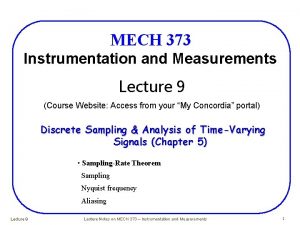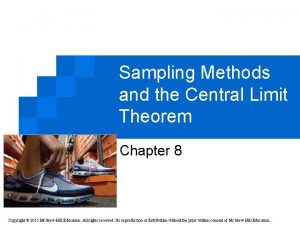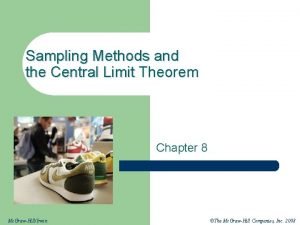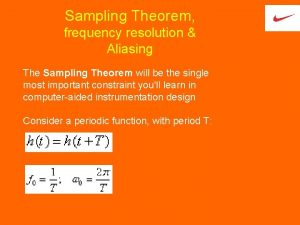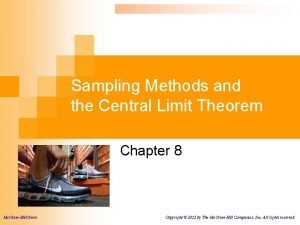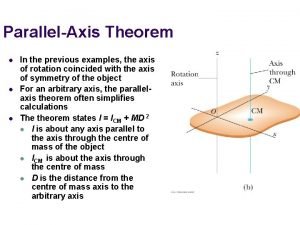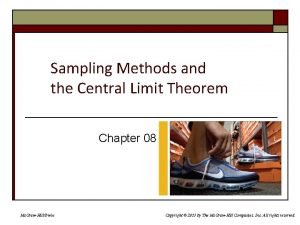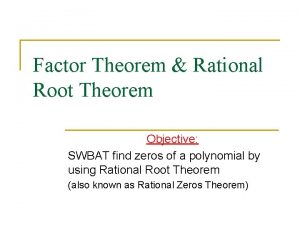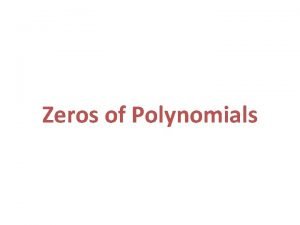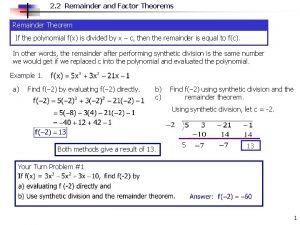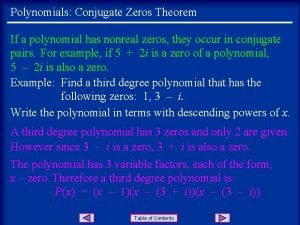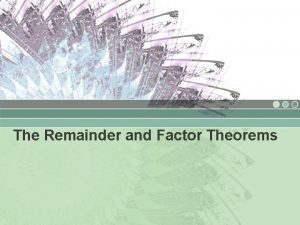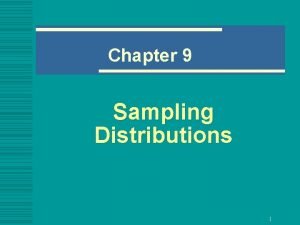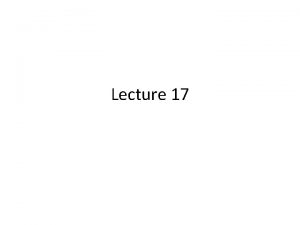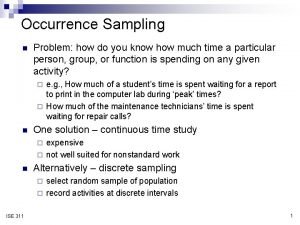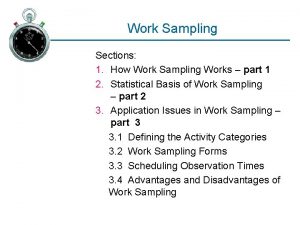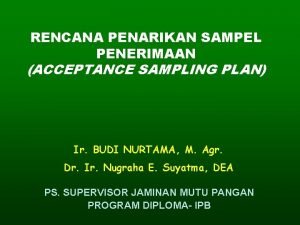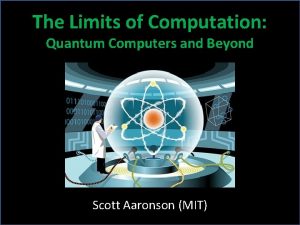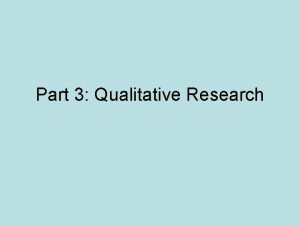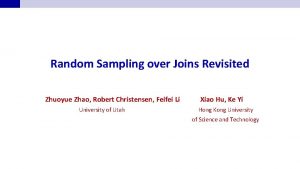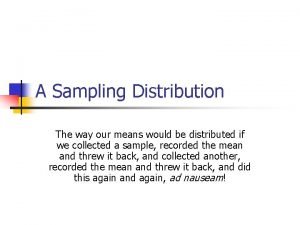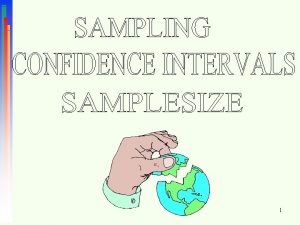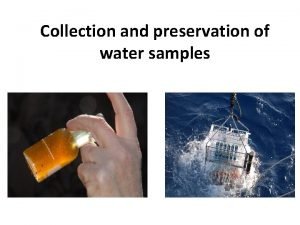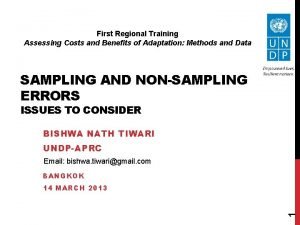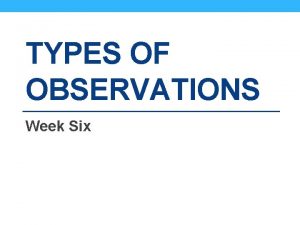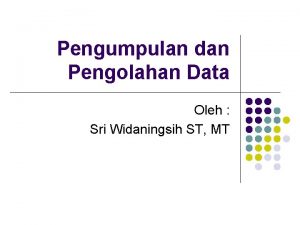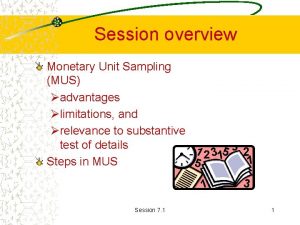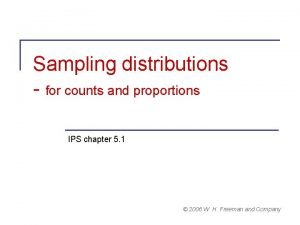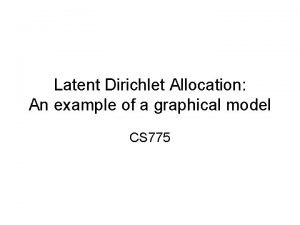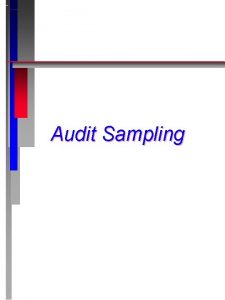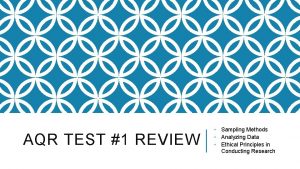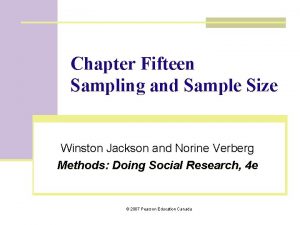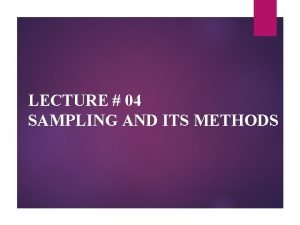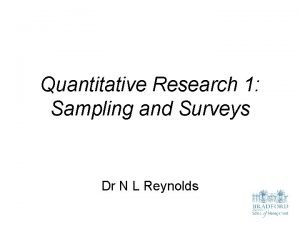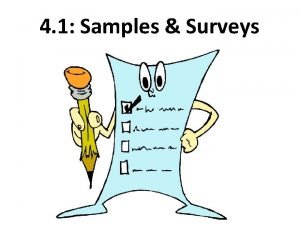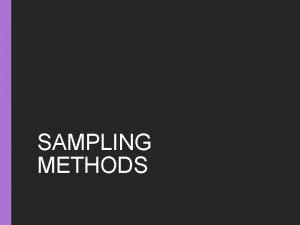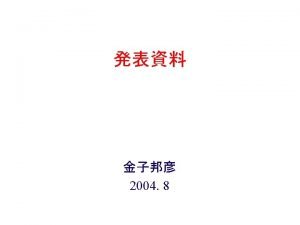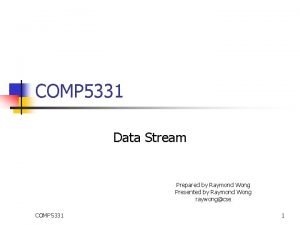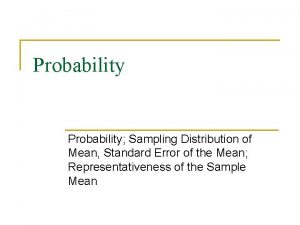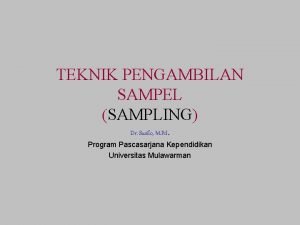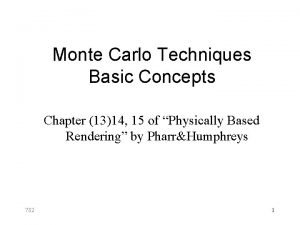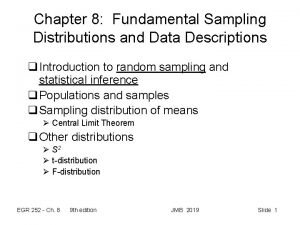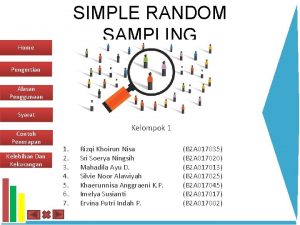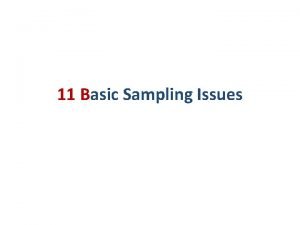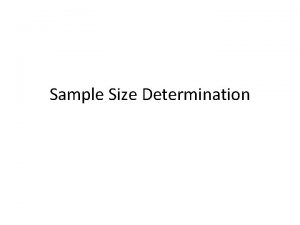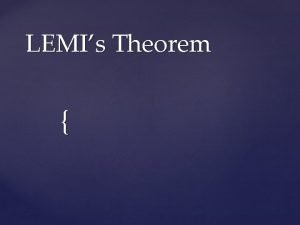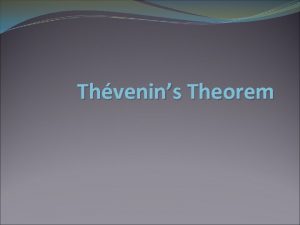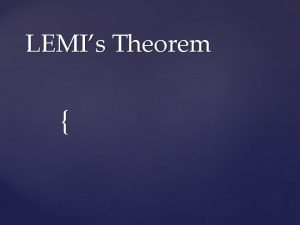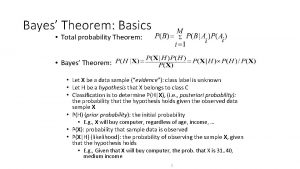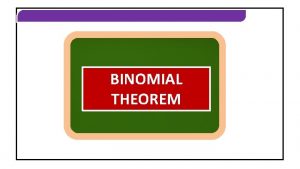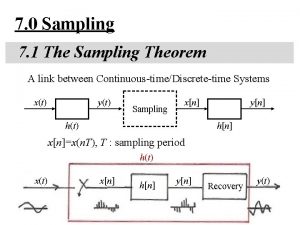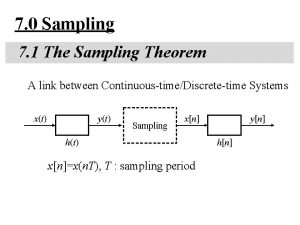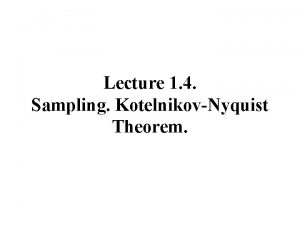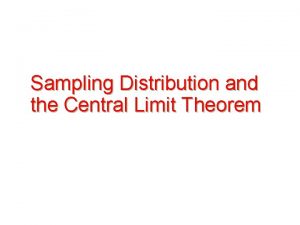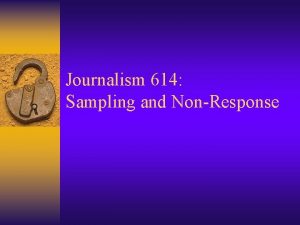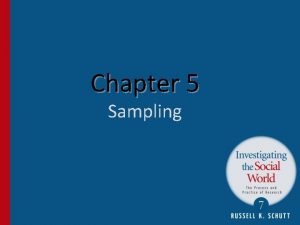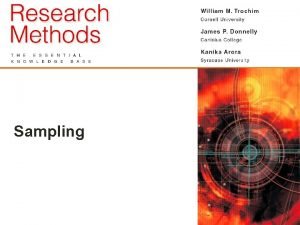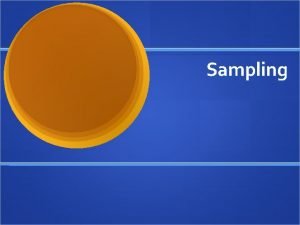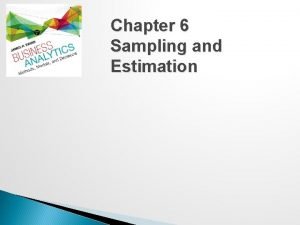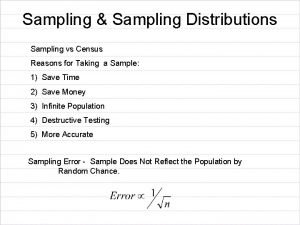7 0 Sampling 7 1 The Sampling Theorem

















































![7. 2 Discrete-time Processing of Continuous-time Signals l Processing continuous-time signals digitally xd[n]=xc(n. T) 7. 2 Discrete-time Processing of Continuous-time Signals l Processing continuous-time signals digitally xd[n]=xc(n. T)](https://slidetodoc.com/presentation_image_h2/6244d993da75f66a3381959ad9566cab/image-50.jpg)








![h(t) x[n] h[n] y(t) Recovery h(t) x[n] h[n] y(t) Recovery](https://slidetodoc.com/presentation_image_h2/6244d993da75f66a3381959ad9566cab/image-59.jpg)























![Impulse Train Sampling of Discrete-time Signals l Interpolation – h[n] : impulse response of Impulse Train Sampling of Discrete-time Signals l Interpolation – h[n] : impulse response of](https://slidetodoc.com/presentation_image_h2/6244d993da75f66a3381959ad9566cab/image-83.jpg)















![Examples • Example 7. 4/7. 5, p. 548, p. 554 of text sampling x[n] Examples • Example 7. 4/7. 5, p. 548, p. 554 of text sampling x[n]](https://slidetodoc.com/presentation_image_h2/6244d993da75f66a3381959ad9566cab/image-99.jpg)













- Slides: 112

7. 0 Sampling 7. 1 The Sampling Theorem A link between Continuous-time/Discrete-time Systems x(t) y(t) Sampling x[n] y[n] h(t) x[n]=x(n. T), T : sampling period h(t) x[n] h[n] y[n] Recovery y(t)

Motivation: handling continuous-time signals/systems digitally using computing environment – accurate, programmable, flexible, reproducible, powerful – compatible to digital networks and relevant technologies – all signals look the same when digitized, except at different rates, thus can be supported by a single network Question: under what kind of conditions can a continuous-time signal be uniquely specified by its discrete-time samples? See Fig. 7. 1, p. 515 of text – Sampling Theorem

Recovery from Samples ? 0 1 2






Impulse Train Sampling See Fig. 4. 14, p. 300 of text – periodic spectrum, superposition of scaled, shifted replicas of X(jω) See Fig. 7. 3, p. 517 of text

Impulse Train Sampling l Sampling Theorem (1/2) – x(t) uniquely specified by its samples x(n. T), n=0, 1, 2…… – precisely reconstructed by an ideal lowpass filter with Gain T and cutoff frequency ωM < ωc < ωs- ωM applied on the impulse train of sample values See Fig. 7. 4, p. 519 of text


Impulse Train Sampling l Sampling Theorem (2/2) – if ωs ≤ 2 ωM spectrum overlapped, frequency components confused --- aliasing effect can’t be reconstructed by lowpass filtering See Fig. 7. 3, p. 518 of text

Aliasing Effect 000

Continuous/Discrete Sinusoidals (p. 36 of 1. 0) 0 1 2 3 4 5

Sampling sampling 0 0 1 2 3 0

Aliasing Effect 0

Sampling Thm 0 0

Recovery from Samples ? (p. 3 of 7. 0) 0 1 2

Practical Sampling (any other pulse shape) x(t) T 1 x(t) T t t T t 0 0 0 t

Practical Sampling (any other pulse shape) 0 0

Impulse Train Sampling l Practical Issues – nonideal lowpass filters accurate enough for practical purposes determined by acceptable level of distortion oversampling ωs = 2 ωM + ∆ ω �� – sampled by pulse train with other pulse shapes – signals practically not bandlimited : pre-filtering

Oversampling with Non-ideal Lowpass Filters 0 0

Signals not Bandlimited 0 0

Sampling with A Zero-order Hold l Zero-order Hold: – holding the sampled value until the next sample taken – modeled by an impulse train sampler followed by a system with rectangular impulse response l Reconstructed by a lowpass filter Hr(jω) See Fig. 7. 6, 7. 7, 7. 8, p. 521, 522 of text



Interpolation l Impulse train sampling/ideal lowpass filtering See Fig. 7. 10, p. 524 of text


Ideal Interpolation

Interpolation l Zero-order hold can be viewed as a “coarse” interpolation See Fig. 7. 11, p. 524 of text l Sometimes additional lowpass filtering naturally applied e. g. viewed at a distance by human eyes, mosaic smoothed naturally See Fig. 7. 12, p. 525 of text





Interpolation l Higher order holds – zero-order : output discontinuous – first-order : output continuous, discontinuous derivatives See Fig. 7. 13, p. 526, 527 of text – second-order : continuous up to first derivative discontinuous second derivative



Aliasing l Consider a signal x(t)=cos ω0 t – sampled at sampling frequency reconstructed by an ideal lowpass filter with xr(t) : reconstructed signal fixed ωs, varying ω0

Aliasing l Consider a signal x(t)=cos ω0 t – when aliasing occurs, the original frequency ω0 takes on the identity of a lower frequency, ωs – ω0 – w 0 confused with not only ωs + ω0, but ωs – ω0 See Fig. 7. 15, 7. 16, p. 529 -531 of text




Aliasing l Consider a signal x(t)=cos ω0 t – many xr(t) exist such that the problem is it is not easy to find the right one – if x(t) = cos(ω0 t + ϕ) the impulses have extra phases ejϕ, e-jϕ –

Sinusoidals (p. 25 of 4. 0)

Aliasing l Consider a signal x(t)=cos (ω0 t + Φ) – (a) (b) (c) (d) phase also changed

Example 7. 1 of Text Sampling is “timevarying” 0 0 0

Example 7. 1 of Text 0 0 0

Example 7. 1 of Text

Examples • Example 7. 1, p. 532 of text (Problem 7. 39, p. 571 of text) sampled and low-pass filtered
![7 2 Discretetime Processing of Continuoustime Signals l Processing continuoustime signals digitally xdnxcn T 7. 2 Discrete-time Processing of Continuous-time Signals l Processing continuous-time signals digitally xd[n]=xc(n. T)](https://slidetodoc.com/presentation_image_h2/6244d993da75f66a3381959ad9566cab/image-50.jpg)
7. 2 Discrete-time Processing of Continuous-time Signals l Processing continuous-time signals digitally xd[n]=xc(n. T) xc(t) C/D Conversion D/A Converter h(t) x[n] h[n] yc(t) D/C Conversion Discrete-time System A/D Converter x(t) yd[n]=yc(n. T) y[n] Recovery y(t)

Formal Formulation/Analysis l C/D Conversion (1) impulse train sampling with sampling period T (2) mapping the impulse train to a sequence with unity spacing – normalization (or scaling) in time

Formal Formulation/Analysis l Frequency Domain Representation ω for continuous-time, Ω for discrete-time, only in this section

Formal Formulation/Analysis l Frequency Domain Relationships – continuous-time (4. 9) – discrete-time (5. 9)

Formal Formulation/Analysis l Frequency Domain Relationships – relationship (7. 6) See Fig. 7. 22, p. 537 of text

C/D Conversion 0 0 1 2 3 4 1 – Xd(ejΩ) is a frequency-scaled (by T) version of Xp(jω) xd[n] is a time-scaled (by 1/T) version of xp(t) – Xd(ejΩ) periodic with period 2π Xp(jω) periodic with period 2π/T=ωs


Formal Formulation/Analysis l D/C Conversion (1) mapping a sequence to an impulse train (2) lowpass filtering

Formal Formulation/Analysis l Complete System See Fig. 7. 24, 7. 25, 7. 26, p. 538, 539, 540 of text equivalent to a continuous-time system if the sampling theorem is satisfied (7. 24 ) (7. 25 )
![ht xn hn yt Recovery h(t) x[n] h[n] y(t) Recovery](https://slidetodoc.com/presentation_image_h2/6244d993da75f66a3381959ad9566cab/image-59.jpg)
h(t) x[n] h[n] y(t) Recovery



Discrete-time Processing of Continuous-time Signals l Note – the complete system is linear and time-invariant if the sampling theorem is satisfied – sampling process itself is NOT time-invariant

Examples l Digital Differentiator – band-limited differentiator – discrete-time equivalent See Fig. 7. 27, 7. 28, p. 541, 542 of text


Examples l Delay – yc(t)=xc(t-∆) – discrete-time equivalent See Fig. 7. 29, p. 543 of text


Examples l Delay – ∆/T an integer – ∆/T not an integer undefined in principle but makes sense in terms of sampling if the sampling theorem is satisfied e. g. ∆/T=1/2, half-sample delay See Fig. 7. 30, p. 544 of text


7. 3 Change of Sampling Frequency Up/Down Sampling 0 0 0 Up Sampling Down Sampling

Impulse Train Sampling of Discrete-time Signals l Completely in parallel with impulse train sampling of continuous-time signals See Fig. 7. 31, p. 546 of text

See Fig. 7. 31, p. 546 of text

(P. 5 of 7. 0)

(P. 7 of 7. 0)

(P. 8 of 7. 0)

Impulse Train Sampling of Discrete-time Signals l Completely in parallel with impulse train sampling of continuous-time signals See Fig. 7. 32, p. 547 of text


Aliasing Effect (P. 13 of 7. 0) 000

Sampling (P. 15 of 7. 0) sampling 0 0 1 2 3 0

Aliasing Effect (P. 16 of 7. 0) Aliasing Effect 0

Aliasing for Discrete-time Signals

Impulse Train Sampling of Discrete-time Signals l Completely in parallel with impulse train sampling of continuous-time signals See Fig. 7. 33, p. 548 of text – ωs < 2ωM, aliasing occurs filter output but xr[n] ≠ x[n] xr[k. N] = x[k. N], k=0, ± 1, ± 2, ……

![Impulse Train Sampling of Discretetime Signals l Interpolation hn impulse response of Impulse Train Sampling of Discrete-time Signals l Interpolation – h[n] : impulse response of](https://slidetodoc.com/presentation_image_h2/6244d993da75f66a3381959ad9566cab/image-83.jpg)
Impulse Train Sampling of Discrete-time Signals l Interpolation – h[n] : impulse response of the lowpass filter – in general a practical filter hr[n] is used


Decimation/Interpolation l Decimation: reducing the sampling frequency by a factor of N, downsampling : two reversible steps – taking every N-th sample, leaving zeros in between – deleting all zero’s between non-zero samples to produce a new sequence (inverse of time expansion property of discrete-time Fourier transform) – both steps reversible in both time/frequency domains See Fig. 7. 34, p. 550 of text


(p. 38 of 5. 0)

(p. 39 of 5. 0)

(p. 37 of 5. 0) l Time Expansion If n/k is an integer, k: positive integer See Fig. 5. 13, p. 377 of text See Fig. 5. 14, p. 378 of text

Decimation/Interpolation l Decimation: See Figs. 7. 34, 7. 35, p. 550, 551 of text



Decimation/Interpolation l Decimation – decimation without introducing aliasing requires oversampling situation See an example in Fig. 7. 36, p. 552 of text


Decimation/Interpolation l Interpolation: increasing the sampling frequency by a factor of N, upsampling – reverse the two-step process in decimation from xb[n] construct xp[n] by inserting N-1 zero’s from xp[n] construct x[n] by lowpass filtering See Fig. 7. 37, p. 553 of text l Change of sampling frequency by a factor of N/M: first interpolating by N, then decimating by M


Decimation/Interpolation 0 012 Interpolation Decimation 012

Decimation/Interpolation 0 0 0
![Examples Example 7 47 5 p 548 p 554 of text sampling xn Examples • Example 7. 4/7. 5, p. 548, p. 554 of text sampling x[n]](https://slidetodoc.com/presentation_image_h2/6244d993da75f66a3381959ad9566cab/image-99.jpg)
Examples • Example 7. 4/7. 5, p. 548, p. 554 of text sampling x[n] without aliasing

Examples • Example 7. 4/7. 5, p. 548, p. 554 of text maximum possible downsampling: using full band [-π, π]

Examples • Example 7. 4/7. 5, p. 548, p. 554 of text

Problem 7. 6, p. 557 of text

Problem 7. 20, p. 560 of text : inserting one zero after each sample : decimation 2: 1, extracting every second sample Which of (a)(b) corresponds to low-pass filtering with ?

Problem 7. 20, p. 560 of text (a) yes : inserting one zero after each sample : decimation 2: 1, extracting every second sample

Problem 7. 20, p. 560 of text (b) no : inserting one zero after each sample : decimation 2: 1, extracting every second sample

Problem 7. 23, p. 562 of text

Problem 7. 23, p. 562 of text

Problem 7. 23, p. 562 of text

Problem 7. 24, p. 562 of text 2

Problem 7. 41, p. 572 of text

Problem 7. 41, p. 572 of text

Problem 7. 52, p. 580 of text dual problem for frequency domain sampling
 Stock theorem
Stock theorem Natural sampling vs flat top sampling
Natural sampling vs flat top sampling Contoh target perilaku dalam observasi
Contoh target perilaku dalam observasi Sampling method in research
Sampling method in research Cluster vs stratified sampling
Cluster vs stratified sampling Convenience sampling example situation
Convenience sampling example situation Convenience sampling method
Convenience sampling method What is stratified sampling
What is stratified sampling Under-sampling
Under-sampling Sampling methods and the central limit theorem
Sampling methods and the central limit theorem Sampling methods and the central limit theorem
Sampling methods and the central limit theorem Fft resolution formula
Fft resolution formula Sampling methods and the central limit theorem
Sampling methods and the central limit theorem Sampling theorem
Sampling theorem Sampling methods and the central limit theorem
Sampling methods and the central limit theorem Rational zero theorm
Rational zero theorm The remainder and factor theorems
The remainder and factor theorems Linear factors theorem and conjugate zeros theorem
Linear factors theorem and conjugate zeros theorem Factor theorem and remainder theorem
Factor theorem and remainder theorem Conjugate zeroes theorem
Conjugate zeroes theorem What is the remainder theorem
What is the remainder theorem Các châu lục và đại dương trên thế giới
Các châu lục và đại dương trên thế giới Tư thế worm breton
Tư thế worm breton ưu thế lai là gì
ưu thế lai là gì Hệ hô hấp
Hệ hô hấp Tư thế ngồi viết
Tư thế ngồi viết Cái miệng nó xinh thế chỉ nói điều hay thôi
Cái miệng nó xinh thế chỉ nói điều hay thôi Mật thư anh em như thể tay chân
Mật thư anh em như thể tay chân Bổ thể
Bổ thể Tư thế ngồi viết
Tư thế ngồi viết Thẻ vin
Thẻ vin V cc cc
V cc cc Thể thơ truyền thống
Thể thơ truyền thống Chúa yêu trần thế alleluia
Chúa yêu trần thế alleluia Các châu lục và đại dương trên thế giới
Các châu lục và đại dương trên thế giới Từ ngữ thể hiện lòng nhân hậu
Từ ngữ thể hiện lòng nhân hậu Khi nào hổ con có thể sống độc lập
Khi nào hổ con có thể sống độc lập Diễn thế sinh thái là
Diễn thế sinh thái là Vẽ hình chiếu vuông góc của vật thể sau
Vẽ hình chiếu vuông góc của vật thể sau 101012 bằng
101012 bằng Tỉ lệ cơ thể trẻ em
Tỉ lệ cơ thể trẻ em Lời thề hippocrates
Lời thề hippocrates đại từ thay thế
đại từ thay thế Quá trình desamine hóa có thể tạo ra
Quá trình desamine hóa có thể tạo ra Các môn thể thao bắt đầu bằng tiếng đua
Các môn thể thao bắt đầu bằng tiếng đua Công thức tiính động năng
Công thức tiính động năng Thế nào là mạng điện lắp đặt kiểu nổi
Thế nào là mạng điện lắp đặt kiểu nổi Hát kết hợp bộ gõ cơ thể
Hát kết hợp bộ gõ cơ thể Khi nào hổ con có thể sống độc lập
Khi nào hổ con có thể sống độc lập Dot
Dot Nguyên nhân của sự mỏi cơ sinh 8
Nguyên nhân của sự mỏi cơ sinh 8 Vẽ hình chiếu đứng bằng cạnh của vật thể
Vẽ hình chiếu đứng bằng cạnh của vật thể độ dài liên kết
độ dài liên kết Chó sói
Chó sói Thiếu nhi thế giới liên hoan
Thiếu nhi thế giới liên hoan điện thế nghỉ
điện thế nghỉ Một số thể thơ truyền thống
Một số thể thơ truyền thống Trời xanh đây là của chúng ta thể thơ
Trời xanh đây là của chúng ta thể thơ Thế nào là hệ số cao nhất
Thế nào là hệ số cao nhất Thế nào là số nguyên tố
Thế nào là số nguyên tố đặc điểm cơ thể của người tối cổ
đặc điểm cơ thể của người tối cổ Phối cảnh
Phối cảnh Real life example of sampling distribution
Real life example of sampling distribution Sample step
Sample step Loterry sampling
Loterry sampling Occurrence sampling
Occurrence sampling Work sampling forms
Work sampling forms Skema single sampling plan
Skema single sampling plan Boson sampling
Boson sampling Feature of qualitative research
Feature of qualitative research Contoh tabel populasi dan sampel penelitian
Contoh tabel populasi dan sampel penelitian Zhuoyue zhao
Zhuoyue zhao Sampling design in research example
Sampling design in research example Real life example of sampling distribution
Real life example of sampling distribution Two-stage cluster sampling example
Two-stage cluster sampling example What is a stratified sampling
What is a stratified sampling Collection and preservation of water samples
Collection and preservation of water samples Sampling error examples
Sampling error examples Sample of anecdotal records of students
Sample of anecdotal records of students Nomogram harry king
Nomogram harry king Monetary unit sample
Monetary unit sample Auspices bias
Auspices bias Sampling distribution of p hat
Sampling distribution of p hat Gibbs sampling example
Gibbs sampling example Distribution of sample variance
Distribution of sample variance Simple random sampling pros and cons
Simple random sampling pros and cons Audit sampling definition
Audit sampling definition Cluster sampling example situation
Cluster sampling example situation Snowball sampling example
Snowball sampling example Yamane formula for sample size
Yamane formula for sample size Sample objectives in quantitative research
Sample objectives in quantitative research Systematic random sampling
Systematic random sampling Sampling distribution simulator
Sampling distribution simulator Consecutive sampling
Consecutive sampling Farthest point sampling
Farthest point sampling Sticky sampling algorithm
Sticky sampling algorithm Quadrat sampling example
Quadrat sampling example Rm sampling
Rm sampling Pps sampling audit
Pps sampling audit Consecutive sampling
Consecutive sampling Incidental sampling
Incidental sampling Standard error of the mean
Standard error of the mean Accidental sampling adalah
Accidental sampling adalah Cosine weighted hemisphere sampling
Cosine weighted hemisphere sampling Cvs and amniocentesis venn diagram
Cvs and amniocentesis venn diagram Sampling techniques
Sampling techniques Example of population and sample
Example of population and sample Kelebihan dan kekurangan teknik simple random sampling
Kelebihan dan kekurangan teknik simple random sampling Sampling bias
Sampling bias Bs6001 sampling plan
Bs6001 sampling plan Nonprobability samples
Nonprobability samples Sample size determination
Sample size determination








